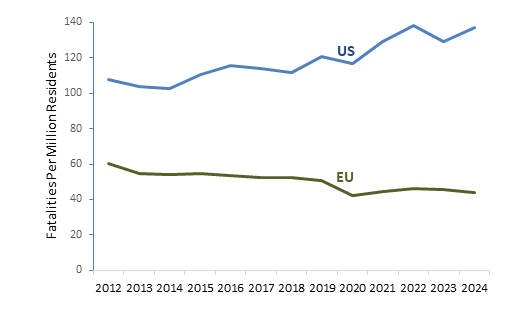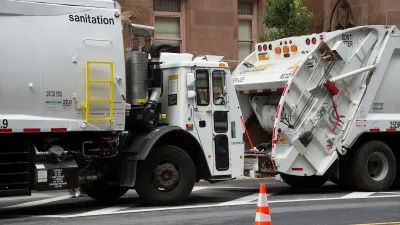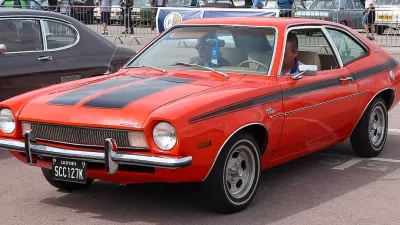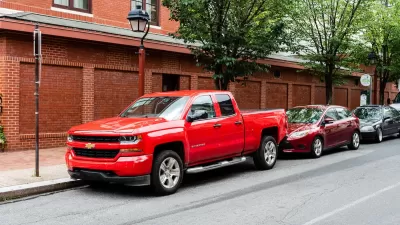EU vehicles are much safer than U.S. vehicles due to better standards. The U.S. wants its standard to be considered ‘equivalent’ for import purposes. A European Transport Safety Council report examines the conflict.

The U.S. government under President Trump is pursuing an aggressive trade policy towards the European Union, threatening tariffs of 25 percent on cars and other goods. According to the European Transport Safety Council (ETSC) new Briefing on Risks to the EU Vehicle Market and Road Safety of Recognising US-market Vehicles as ‘Equivalent’, this would be a catastrophic mistake, and the consequences would be measured in the deaths on EU roads.
Road safety trends in the U.S. and EU
Since 2013, road deaths in the EU decreased by 16 percent. Higher vehicle safety standards are a key driver of this improvement. In the US, over the same period road deaths have increased by 25 percent due in part to larger, heavier SUVs and light trucks, as well as weaker vehicle safety requirements.

Are EU and US standards equivalent?
ETSC was a stakeholder consulted on vehicle safety issues during negotiations for TTIP during the Obama administration. A study commissioned by the car industry found that EU models were, on average, 33 percent safer in terms of risk of a serious injury in common front-side crashes.
A fundamental difference in policy approach between the two markets is that EU vehicle safety policy takes account of all road users, not just those protected inside motor vehicles. The EU has had pedestrian protection requirements affecting vehicle front-end design for cars and vans since the mid-2000s, which have been upgraded in the years since. The United States has no such requirements.
Since March 2018, all cars and vans in the EU are required to be fitted with an automated emergency calling system known as e-call, which can operate in the event of a crash in the case where the driver may be unable to call for help. The US does not require mandatory fitting of an emergency calling system.
Since September 2019, the EU has required that all new cars be fitted with seatbelt reminder systems in all front and rear seating positions. The US does not currently require reminders apart from on the driver’s seat — though it could introduce such a requirement in 2026-7 if the new administration maintains a new Biden-era rule.
Since July 2022, new vehicles sold in the EU have been subject to a newer and significantly safer standard defined in the updated General Safety Regulation. The entry into force of the various standards depends on the vehicle type and applies first to new types, with longer lead times for new vehicles already on the market.
New safety features required in all new vehicles in the EU from July 2024:
- Intelligent speed assistance
- Reversing detection with camera or sensors
- Attention warning in case of driver drowsiness
- Emergency stop signal
- Cybersecurity measures
Additional features required for new cars and vans:
- Lane keeping assistance
- Advanced emergency braking detecting obstacles and moving vehicles ahead
- Event data recorders
Additional features required for new buses and trucks:
- Detection and warnings to prevent collisions with pedestrians or cyclists
- Tyre pressure monitoring systems (already required for cars and vans)
Further measures to be progressively introduced for all new vehicles in the EU between July 2024 and July 2029
- Advanced driver distraction warning
- Safe and longer-lasting tyre performance
Additional features required for new cars and vans:
- Safety glass
- Advanced Emergency Braking systems that can detect pedestrians and cyclists
Additional features required for new buses and trucks:
- Improved direct vision
- Event data recorders
The new safety measures will help to better protect passengers, pedestrians and cyclists across the EU, and are expected to save over 25,000 lives and avoid at least 140,000 serious injuries by 2038. The vast majority of these new requirements are not required by US legislation. Backup cameras have been a requirement on new US cars since 2018. The US had planned to require Automated Emergency Braking as of 2029 – but that rulemaking has been suspended by the Trump administration.
Vehicle automation
The U.S. and EU have very different approaches to vehicle automation. Tesla’s “Full Self Driving” driver assistance system has been allowed to operate legally on American roads, but is subject to mandatory incident reporting and is currently under investigation by US federal authorities. Tesla’s FSD system is not permitted on E.U. roads. In the EU such systems are regulated by EU and UNECE regulations, and are subject to vehicle type approval testing. If the EU were to consider US vehicles as ‘equivalent’ to complying with E.U. standards, would that extend to automation functions? If so, how would such systems be regulated as the EU has no central regulatory authority for vehicle safety or crash investigation ?
For more information:
Top European safety groups warn against lowering standards with U.S. vehicle imports
FULL STORY: Briefing on risks to the EU vehicle market and road safety of recognising US-market vehicles as ‘equivalent’

Alabama: Trump Terminates Settlements for Black Communities Harmed By Raw Sewage
Trump deemed the landmark civil rights agreement “illegal DEI and environmental justice policy.”

Study: Maui’s Plan to Convert Vacation Rentals to Long-Term Housing Could Cause Nearly $1 Billion Economic Loss
The plan would reduce visitor accommodation by 25% resulting in 1,900 jobs lost.

Why Should We Subsidize Public Transportation?
Many public transit agencies face financial stress due to rising costs, declining fare revenue, and declining subsidies. Transit advocates must provide a strong business case for increasing public transit funding.

Paris Bike Boom Leads to Steep Drop in Air Pollution
The French city’s air quality has improved dramatically in the past 20 years, coinciding with a growth in cycling.

Why Housing Costs More to Build in California Than in Texas
Hard costs like labor and materials combined with ‘soft’ costs such as permitting make building in the San Francisco Bay Area almost three times as costly as in Texas cities.

San Diego County Sees a Rise in Urban Coyotes
San Diego County experiences a rise in urban coyotes, as sightings become prevalent throughout its urban neighbourhoods and surrounding areas.
Urban Design for Planners 1: Software Tools
This six-course series explores essential urban design concepts using open source software and equips planners with the tools they need to participate fully in the urban design process.
Planning for Universal Design
Learn the tools for implementing Universal Design in planning regulations.
Smith Gee Studio
Alamo Area Metropolitan Planning Organization
City of Santa Clarita
Institute for Housing and Urban Development Studies (IHS)
City of Grandview
Harvard GSD Executive Education
Toledo-Lucas County Plan Commissions
Salt Lake City
NYU Wagner Graduate School of Public Service





























